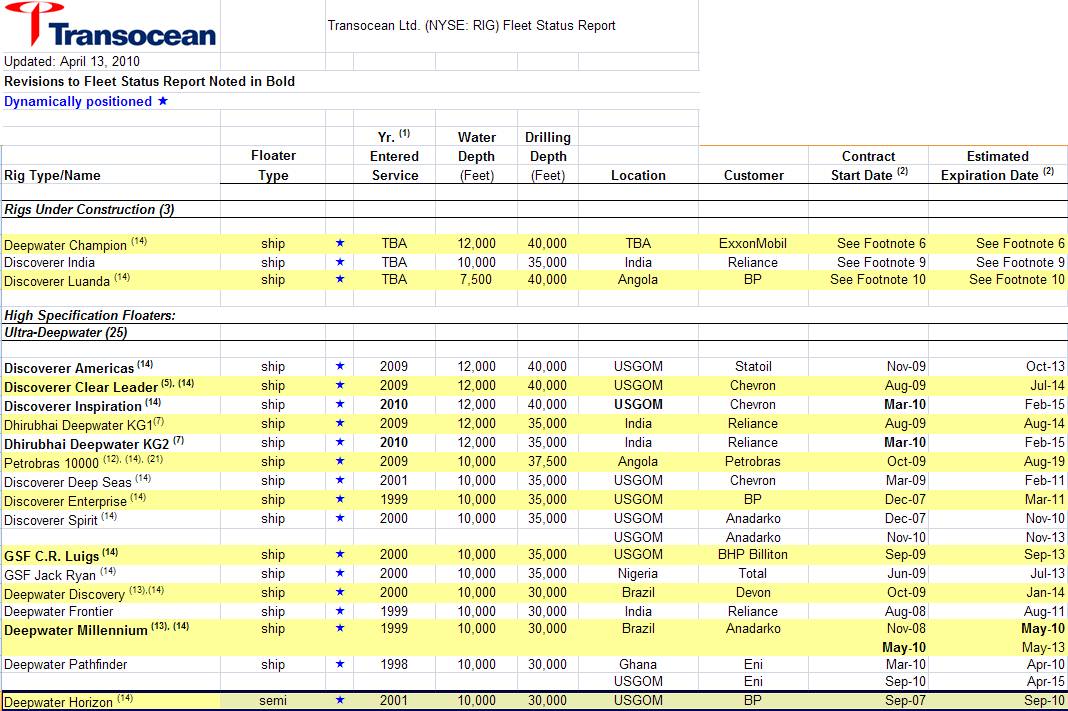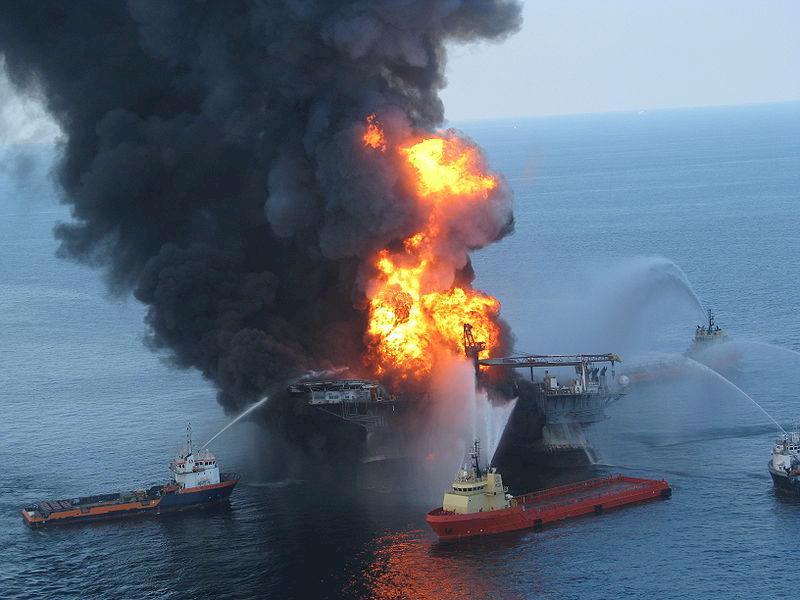June 4, 2010 - The Mexican Gulf Ecological Disaster
President Obama Acts Surprised and Tells Larry
King of CNN on 3 June that he is "Furious"
< Previous |
Next >
Something Is Fishy About What President Obama Says
Yesterday on Larry King's 9PM (EDT) CNN show, U.S.
President Obama said he was "furious" at the ecological disaster unfolding
in the Gulf of Mexico.
Obama nevertheless managed to downplay the impact saying he
still supports off-shore drilling "if it can be done safely." In all the
interview there was more than a little too much fishiness in what Obama had
to say. He stopped himself short saying The U.S. Coast Guard is responsible
for the clean-up.
"I would love to just spend a lot of my time venting and yelling at
people, but that's not the job I was hired to do," Obama said. "My
job is to solve this problem and ultimately this isn't about me and how
angry I am. Ultimately this is about the people down in the Gulf who are
being impacted and what am I doing to make sure that they're able to salvage
their way of life."
Oil giant BP caused the spill and is responsible for paying the
costs, Obama said, adding: "My job is to make sure they're being
held accountable."
One has to wonder why the joint hearings by the U.S. Coast Guard and
Minerals Management Service would continue if President Obama has
already made the decision to place the blame squarely on British Petroleum.
The hearings have indicated otherwise.
Most industry observers, and the joint hearings by the U.S. Coast
Guard and Minerals Management Service seem to put the technical
blame squarely on British Petroleum's American Contractors, Halliburton
and Transocean and it was the U.S. government that approved and
applauded the ultra deep water drilling that has seen the TransOcean-owned
"Deepwater Horizon" semi-submersed drilling platform boring many miles
below the ocean sea bed, even a mile beyond its rated capability.
Halliburton Co. is an American company
contracted to BP and the
world's second largest oilfield services corporation with
operations in more than 70 countries once led by
former U.S. VP Dick Cheney and a key player as a controversial contractor
rebuilding Iraq . The company has recently been told to lay low.
"Halliburton is engaged in discussions with its
customers and anticipates relocating equipment and personnel to
other markets as appropriate," the company said in a filing with
regulators after the U.S. government's sudden May 2010 halt of
deepwater drilling.
Transocean is another American company contracted to BP,
and the world's largest offshore drilling company, owner and operator of the
now destroyed Deepwater Horizon for which British Petroleum was paying
Transocean over a quarter million dollars a day (see proprietary Transocean
Document).
It would seem that the U.S. President is doing everything possible
to divert attention from the disastrous mess in the Mexican Gulf.
He even went as far as commenting on the status of pending free agent
basketball star Lebron James, saying that part of him hoped James would
re-sign with the Cleveland Cavaliers because it would be a "great story."
In another diversion he attacked a new Arizona law, which takes effect in
July, allowing police officers to check the residency status of anyone who
is being investigated for a crime.
On 2 June former Beatle Sir Paul McCartney serenaded the first lady
at The White House with the love ballad that shares her first name,
"Michelle." What next?
It's the typical criminal pattern for answering questions from the
police: express surprise; show concern; blame someone else; try
create a diversion; and failing that, then deny, deny, deny.
But DeepWater Horizon Explosion Was No Surprise
Shortly before the explosion and loss of "Deepwater
Horizon" (see explosion),
Transocean had been
boasting of it's September 2009 success wherein the
"Deepwater Horizon" offshore, partially submerged drilling rig
had established a 35,050ft (10,680m) well, the deepest well in
history -- more than 5,000 feet deeper than its stated design
specification which was reported to be 30,000 feet on April 13th, 2010. ( see proprietary Transocean
Document)
At the time of the
explosive blowout that destroyed
"Deepwater Horizon", the well
extended 5486 meters (3.4 miles) beneath the sea floor in some 1500
meters (1 mile deep) of sea water.
Deepwater Horizon 's drill shaft integrity failure
may have come in the cement injected by Halliburton Inc.
between the well wall and its steel liner, experts say. Halliburton
workers had just finished the "cement job."
Problems with cement were the cause of 18 of 39 blowouts
in the Gulf of Mexico over a 14-year period, according to a
2007 report from the U.S. Minerals Management Service, the agency
that supervises offshore drilling.
According to early investigations, oil and gas
rushing up the drill riser (a Blow-Out) exploded in the shaft.
Drilling through pressurized rock from over a mile
deep in the ocean and more than 3.4 miles into the earth's crust
below the sea bed has its known perils.
Tests Predicted Blow-Out Preventer Failure
Explosive rushes of gas and oil are the reason such
wells have a Blow-Out Preventer (BOP) which is a valve that sits over the
well on the sea bed and immediately shuts when pressures exceed
pre-set limits. Tests had been run on the valve hours before the
blow-out and the BOP Valve test failed!
In the case of "Deepwater Horizon" disaster, the Blow-Out Preventer
did fail as previous tests said it would
In the joint hearings by the U.S. Coast Guard and Minerals
Management Service, there have been numerous conflicted
testimonies by the Halliburton 'cementers' and their task masters.
The Halliburton company employee who performed several of
the cement lining jobs on the "Deepwater Horizon" said on May 28, 2010 that
only the deepest casing in the well was done with a new kind of
light, quicker-curing nitrogen-infused cement.
Testimony from cementer
Christopher Haire was something of a surprise because Jimmy
Harrell, the top drilling official on the rig when it exploded in
the Gulf on April 20, testified that the rig had only used the
nitrified cement on shallower casings. Harrell said he'd been warned
that nitrogen from the cement could get in the well hole and cause
problems.
|
Original
 Press
Release Press
Release
Deepwater Horizon
 Transocean
Ltd. (NYSE: RIG) announced that its ultra-deepwater semisubmersible
rig Deepwater Horizon recently drilled the deepest oil and gas well
ever while working for BP and its co-owners on the Tiber well in the
U.S. Gulf of Mexico. Working with BP, the Transocean crews on the
Deepwater Horizon drilled the well to 35,050 vertical depth and
35,055 feet measured depth (MD), or more than six miles, while
operating in 4,130 feet of water. Transocean
Ltd. (NYSE: RIG) announced that its ultra-deepwater semisubmersible
rig Deepwater Horizon recently drilled the deepest oil and gas well
ever while working for BP and its co-owners on the Tiber well in the
U.S. Gulf of Mexico. Working with BP, the Transocean crews on the
Deepwater Horizon drilled the well to 35,050 vertical depth and
35,055 feet measured depth (MD), or more than six miles, while
operating in 4,130 feet of water.
"This impressive well depth record reflects the intensive planning
and focus on effective operations by BP and the drilling crews of
the Deepwater Horizon," said Robert L. Long, Transocean Ltd.'s Chief
Executive Officer. "Congratulations to everyone involved."
These achievements are the latest in Transocean's history of world
and other records dating back to the 1950s. In 2005, the
ultra-deepwater drillship Discoverer Spirit set the record for the
longest Gulf of Mexico oil and gas well at 34,189 feet, MD. Most
recently, the Transocean jackup GSF Rig 127 drilled the industry’s
longest extended-reach well in 2008 while working for Maersk Oil
Qatar AS at 40,320 feet MD with a 35,770-foot horizontal section.
The well was drilled offshore Qatar in 36 days and was
incident-free.
Transocean also holds the current world water-depth record of
operating in 10,011 feet of water set while working for Chevron in
the U.S. Gulf of Mexico.
The Deepwater Horizon, placed into service in 2001, is a dynamically
positioned ultra-deepwater semisubmersible rig capable of working in
water depths of up to 10,000 feet.
Transocean Ltd. is the world’s largest offshore drilling contractor
and the leading provider of drilling management services worldwide.
With a fleet of 135 mobile offshore drilling units plus eight
announced ultra-deepwater newbuild units, the company’s fleet is
considered one of the most modern and versatile in the world due to
its emphasis on technically demanding segments of the offshore
drilling business. The company owns or operates a contract drilling
fleet of 41 High-Specification Floaters (Ultra-Deepwater, Deepwater
and Harsh-Environment semisubmersibles and drillships), 26 Midwater
Floaters, 10 High-Specification Jackups, 55 Standard Jackups and
other assets utilized in the support of offshore drilling activities
worldwide.
|
The well blueprint had changed several times before
the accident, in which natural gas and oil got into the
well and despite the Blow-Out Preventer which should have closed,
were allowed to shoot up the riser to the rig, igniting in huge fireballs.
Cement Was Failing And There Were Possible Leaks In The Well
Contrary to prior testimony from other rig leaders
and British Petroleum's drilling engineer that tests gave no reason
for concern and conditions were safe for the "Deepwater Horizon" to
displace heavy drilling mud the evening of April 20, 2010, the rig's
subsea supervisor testified that workers were confused by some test
results that showed possible leaks in the well.
The man in charge of the blowout preventer and
other well systems on the sea floor, Chris Pleasant, said he was
part of lengthy discussions about fluid losses during a negative
pressure test about four hours before the accident. In a negative
pressure test, the well head is shut off using annular valves in the
massive blowout preventer device on the sea floor, and workers
measure whether pressure causes any mud to come up to the rig from
the marine riser that runs down to the well.
Pleasant said when he began his shift that day, he
went to the drill floor and found a tool-pusher, one of the main
drilling crew, discussing results of the negative pressure test with
Robert Kaluza, BP's top official on the rig. He said the
tool-pusher, Wyman Wheeler, was concerned that barrels of mud had
leaked out during the pressure test. The workers disagreed about
where the mud had been lost.
Pleasant said Kaluza, who invoked his Fifth Amendment right
against self-incrimination to avoid testifying, was the one
who insisted that the test results weren't satisfactory.
"Bob Kaluza said that according to APD (the rig's permit to
drill), we didn't achieve the results," Pleasant said.
Similarly, Christopher Haire, a cementer for Halliburton,
said drillers were "unsatisfied" with the negative test,
which returned 15 barrels of mud, rather than the ideal of no mud
released.
And yet, the top drilling official on the rig,
Offshore Installation Manager Jimmy Harrell, and BP's well designer
on shore, Mark Hafle, testified previously that they believed the
pressure tests were successful and no cause for concern.
Conflicting testimony has also been noted about the
cement bond log, considered by engineers to be the "gold standard"
of testing cement jobs. |

 Deepwater
Horizon Burning - 21 April 2010 (US Coast Guard Photo)
Deepwater
Horizon Burning - 21 April 2010 (US Coast Guard Photo)
< Previous |
Next >
-Ruffian.Angel at Themismusic.com
|


 Press
Release
Press
Release


